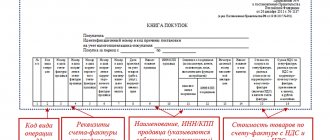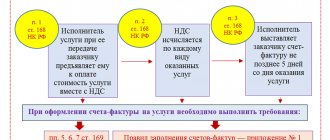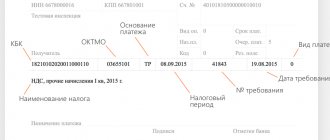Tax returns must indicate the tax period code. Digital designations of periods depend on the type of declaration. We’ll figure out what codes to use when reporting taxes in this article.
The tax period code includes two digits. In addition to declarations, such a code is placed on tax bills. Thanks to these codes, Federal Tax Service inspectors determine the reporting period for the submitted declaration. Also, such a code will make it clear to the Federal Tax Service that the company is being liquidated (during liquidation, its own code is inserted).
Submit electronic reports via the Internet. The Kontur.Extern service gives you 3 months free of charge!
Try it
Types of tax periods
According to paragraph 1 of Article of the Tax Code of the Russian Federation, the tax period is a period of time at the end of which the final tax base is determined and the final amount of tax is calculated, which must be transferred to the budget.
The specific tax period for each tax is established in Part 2 of the Tax Code (in the chapter devoted to the relevant tax). This period varies from a month to a year. The period of time at the end of which you need to calculate the total amount of the trading fee is called the taxation period, and the insurance premiums are called the settlement period.
Fill out, check and submit a new insurance premium calculation online for free
Consequences of incorrectly filling out field 107
Filling out field 107 “Tax period” incorrectly does not result in the payment to the budget being recognized as not transferred. Consequently, the payer can clarify the payment provided that he independently discovers the error (clause 7 of Article 45 of the Tax Code of the Russian Federation).
To clarify the payment, you must submit to the Federal Tax Service a statement of the error, drawn up in any form, and attach a copy of the payment order to it. If necessary, a joint reconciliation of paid taxes is carried out, based on the results of which a report is drawn up. Based on this act and a written statement about the error, the tax authority makes a decision to clarify the payment.
How is the tax period determined?
We have compiled data on the duration of periods for all taxes, as well as insurance premiums and trading fees, into a table.
| Length of period | Tax name | Article of the Tax Code of the Russian Federation |
| Month | Excise taxes | 192 |
| MET | 341 | |
| Gambling tax | 368 | |
| Quarter | VAT | 163 |
| Water tax | 333.11 | |
| UTII | 346.30 | |
| Trade fee | 414 | |
| Year | Personal income tax | 216 |
| Income tax | 285 | |
| Tax on additional income from hydrocarbon production | 333.53 | |
| Unified agricultural tax | 346.7 | |
| simplified tax system | 346.19 | |
| PSN (if the patent is issued for a shorter period, the tax period is the period for which the patent was issued) | 346.49 | |
| Transport tax | 360 | |
| Organizational property tax | 379 | |
| Land tax | 393 | |
| Property tax for individuals | 405 | |
| Insurance premiums | 423 |
Submit all tax returns online for free
What is the difference between tax and reporting periods
In accordance with paragraph 1 of Article of the Tax Code of the Russian Federation, a tax period may consist of one or more reporting periods. For example, it could be a month, two months, three months, etc., first quarter, second quarter, third quarter, half a year, 9 months. At the end of each reporting period, the taxpayer determines the interim base and contributes the amount of the advance payment to the budget.
As you can see, tax and reporting periods differ in the basis for calculating the amount that needs to be transferred at the end of the corresponding period of time. For the reporting period, this is a kind of “incomplete” base. It can be calculated based on actual data on income, expenses or payments for an intermediate period of time. Or it can be conditional, that is, determined based on data for previous periods or by calculation method. As for the tax period, the payment is always calculated based on the real financial result for the corresponding period of time.
REFERENCE
There may be situations where the final tax will be less than the advance payments made during the year. In this case, the taxpayer will have an overpayment, which can be returned or offset (Article of the Tax Code of the Russian Federation).
Submit an application for credit or refund of taxes (contributions) via the Internet Submit for free
Definition and indicators
The start and end dates of tax periods for newly created or closed enterprises may be changed. Intervals are also subject to adjustment in the event of reorganization measures. If a legal entity is liquidated or is in the process of reorganization, the tax period for it in the last year of activity will begin on January 1 and end with the last day of the company's existence. A similar approach to determining the period for removing the tax base is used in relation to individuals ceasing their commercial activities. The end of activity is evidenced by the fact of state registration of completion of operation.
During reorganization, a new business entity may be created. For him, the tax period begins not from the first days of January, but from the day of registration with government bodies and registration with the Federal Tax Service. The last day of the period will be the same as for other enterprises.
IMPORTANT! A separate rule for determining the tax period is provided for entities that were registered in December and officially ceased their activities in this month within one year. For them, the tax period will be equal to the period of work of a legal entity or individual.
In the case of quarterly intervals, when creating a new business entity, the tax period will be from the date of formation of the company or individual entrepreneur until the end of the quarter. If there are less than 10 days left until the end of the quarterly period after registration of a legal entity, then the days remaining from the current period are added to the next quarterly period of time.
Termination of activity with a quarterly frequency of tax assessment creates grounds for changing the period of formation of the taxable base - the results must be summed up in the range from the first day of the quarter to the day of registration of the termination of commercial activity.
If the tax period is indicated by a monthly interval, then newly created organizations must take into account the time from the day the business was opened until the last day of the month in calendar terms. When information appears in the unified state registers about the termination of activities by an individual business entity, the tax period at a monthly rate will be established from the first day of the current month until the last day of operation of the enterprise or individual entrepreneur.
REMEMBER! The general rules for determining the boundaries of the tax period do not apply to taxes that are calculated in connection with the application of the patent taxation scheme and the regime of work with tax on imputed income.
For foreign organizations, the beginning of the tax period is regulated by the date of submission to the Federal Tax Service of an application for tax resident status with foreign capital. If the notice indicates the start of work on January 1, then the tax period will be counted from this day. If the application is submitted during the calendar year and it is mentioned that the dates of commencement of activities as a resident and the submission of the document coincide, then the countdown begins from the date of submission of the document.
The tax period in the settlement documentation is indicated in a specially designated field. There are 10 cells to indicate this indicator:
- eight of them are for symbolic meanings;
- two of them are used to set dividing marks in the form of dots.
Specifying the tax period indicator allows you to identify the estimated time range, the date by which the tax or fee must be paid. Period designation scheme in the document:
- The first two characters determine the frequency of payments: monthly (MS), quarterly (QU), semi-annual (SL), annual (AH).
- In the cell of the third character, a separating character is inserted - a dot.
- The fourth and fifth cells are needed to indicate the serial number of the period.
- The sixth character is the separator.
- The remaining numerical values indicate the year for which the tax liability is accrued and paid.
Codes for tax reporting periods in 2021
The amount of tax or advance payment that needs to be transferred to the budget is reflected in the tax return (if reporting is submitted for this tax or “advances”). The forms of the relevant declarations require a mandatory indication of the period for which the tax liability is calculated. In this case, information about the tax or reporting period is not written down in words, but is encoded as a number. This is necessary for machine processing of declarations.
Tax period codes for VAT
The following codes are used in the VAT declaration (Appendix No. 3 to the Procedure for filling out the declaration, approved by Order of the Federal Tax Service dated October 29, 2014 No. ММВ-7-3/ [email protected] ):
| 21 | I quarter |
| 22 | II quarter |
| 23 | III quarter |
| 24 | IV quarter |
| 51 | I quarter during reorganization (liquidation) of the organization |
| 54 | II quarter during reorganization (liquidation) of the organization |
| 55 | III quarter during reorganization (liquidation) of the organization |
| 56 | IV quarter during reorganization (liquidation) of the organization |
Also see “New VAT return form: how to submit reports for the first quarter quickly and without errors.”
Fill out, check and submit a new VAT return through Kontur.Extern Submit for free
Encoding table
As we noted above, remembering the encodings for each form and type of fiscal declarations and other reporting is quite difficult. An error when filling out a form can be costly for a company. For example, an accountant will indicate an incorrect code in the report, therefore, tax authorities will not take into account the submitted information and will impose a fine for late provision of information.
To eliminate errors when filling out forms and forms in the Federal Tax Service, use a professional guide, which presents all the current encodings for the types of fiscal forms.
Codes of tax periods according to the simplified tax system
The following codes are used in the declaration under the simplified tax system (Appendix No. 1 to the Procedure for filling out the declaration, approved by order of the Federal Tax Service dated February 26, 2016 No. MMV-7-3 / [email protected] ):
| 34 | Calendar year |
| 50 | Last tax period upon reorganization (liquidation) of an organization or upon termination of activities as an individual entrepreneur |
| 95 | Last tax period when switching to a different taxation regime |
| 96 | Last tax period upon termination of business activity in general or upon termination of business activity in respect of which the taxpayer applied the simplified tax system |
Also see “From April 10, a new declaration form under the simplified tax system will come into effect.”
Submit a free notification of the transition to the simplified tax system and submit a declaration under the simplified tax system via the Internet
Ciphers and codes in payment orders
When preparing payment orders to pay fiscal obligations in favor of the Federal Tax Service, a completely different encoding is used. The payment slip indicates a ten-digit format code: “XX.XX.YYYY”, where XX is the letter and numeric designation of the time period for which the taxpayer transfers the tranche to the state budget, YYYY is the calendar year for which budget payments are calculated.
For example:
- quarterly calculations - “Q.0X.2020”. Payment of VAT for the 3rd quarter - “KV.03.2020”;
- the monthly payment, for example, for September, is designated “MS.09.2020”;
- semi-annual payment: “PL.01.2020” - for the first half of the year and “PL.02.2020” - for the second;
- payment based on the results of the calendar year is designated “GD.00.2020”.
Tax period codes for UTII
The UTII declaration uses the following codes (Appendix No. 1 to the Procedure for filling out the declaration, approved by order of the Federal Tax Service dated June 26, 2018 No. ММВ-7-3/ [email protected] ):
| 21 | 1st quarter |
| 22 | 2nd quarter |
| 23 | 3rd quarter |
| 24 | 4th quarter |
| 51 | 1st quarter during reorganization (liquidation) of the organization |
| 54 | 2nd quarter during reorganization (liquidation) of the organization |
| 55 | 3rd quarter during reorganization (liquidation) of the organization |
| 56 | 4th quarter during reorganization (liquidation) of the organization |
Also see: “A new form of UTII declaration has been approved.”
Connect to the service to fill out and send the UTII declaration in the current format
Codes of tax periods for income tax
The following codes are used in the income tax return (Appendix No. 1 to the Procedure for filling out the declaration, approved by Order of the Federal Tax Service dated September 23, 2019 No. ММВ-7-3/ [email protected] ):
| 21 | first quarter |
| 31 | half year |
| 33 | nine month |
| 34 | year |
| 35 | one month |
| 36 | two month |
| 37 | three months |
| 38 | four months |
| 39 | five months |
| 40 | six months |
| 41 | seven months |
| 42 | eight months |
| 43 | nine month |
| 44 | ten months |
| 45 | eleven months |
| 46 | year |
| 50 | last tax period during reorganization (liquidation) of the organization |
Also see “Income tax return for 2021 must be submitted using a new form.”
Fill out and submit a current income tax return via the Internet Submit for free
Tax period 34
Code 34 in most cases corresponds to a tax period equal to a calendar year. For example, this is the code that is entered in declarations for the simplified tax system, personal income tax and corporate property tax.
When filling out income tax reporting, you need to take into account the following nuance. In the annual return, code 34 is indicated by those taxpayers who submit returns quarterly. If the organization reports profit monthly, then the final declaration contains the number 46, which also indicates the year.
Main purpose
To indicate the specific period of time for which the fiscal reporting form was compiled, a special codification is provided. The code is a two-digit number, for example, tax period: 22, 34, 50.
This codification is a very convenient grouping of reporting according to the time of its formation. For example, this code allows you to quickly determine for what period of time the taxpayer made the calculation and calculated the tax to the budget.
For each type or tax reporting code (TRR), an individual codification procedure is provided. Let's look at how codes are determined for the main types of reports to the Federal Tax Service.
The category and status of the taxpayer does not matter to determine the coding. That is, the Federal Tax Service approves codes individually for each form or report form, regardless of the type of payer of fees, contributions and taxes. That is, this coding is used by legal entities, individual entrepreneurs, private practices, and ordinary citizens.
Codes for the reporting period of financial statements in 2020
In accounting, the reporting period is the period for which the organization must prepare financial statements (clause 4 of PBU 4/99). For annual financial statements, this period is the calendar year - from January 1 to December 31 inclusive. An exception applies to cases of creation, reorganization (except transformation) and liquidation of a legal entity (Clause 1, Article 15 of the Federal Law of December 6, 2011 No. 402-FZ “On Accounting”).
ATTENTION
In financial statements, data on periods is not coded, but is indicated by entering the date, month and year.
The form of the balance sheet (approved by order of the Ministry of Finance dated July 2, 2010 No. 66n) does not provide for coding the reporting period. Specific reporting dates are indicated on the title page and in the table with indicators, rather than period codes. In the same way, that is, without using codes, data on periods is filled out in the form of the Statement of Financial Results.
Also see “The balance sheet for 2021 will need to be submitted using a new form.”
Prepare, check and submit financial statements to the Federal Tax Service via the Internet Submit for free
How to determine the code for personal income tax payment
If personal income tax is paid by an organization or individual entrepreneur for its employees, then field 107 is filled out according to generally accepted standards. That is, when paying personal income tax for September of this year, the payment slip indicates “MS. 09.2020.”
If the payment is made for the taxpayer himself, officials have provided exceptions. For example, if an individual entrepreneur transfers personal income tax to the budget for himself and the individual entrepreneur applies the basic taxation system. Taxpayers in this category are required to pay personal income tax within the following deadlines: until July 15 and until October 15 of the reporting year for advance payments, until January 15 of the following year for the final payment.
Therefore, when transferring an advance or final personal income tax payment to an individual entrepreneur for himself, it is necessary to indicate a specific date. For example, an individual entrepreneur at OSNO pays an advance on personal income tax for January-June 2021, entered in field 107 on July 15, 2020.








